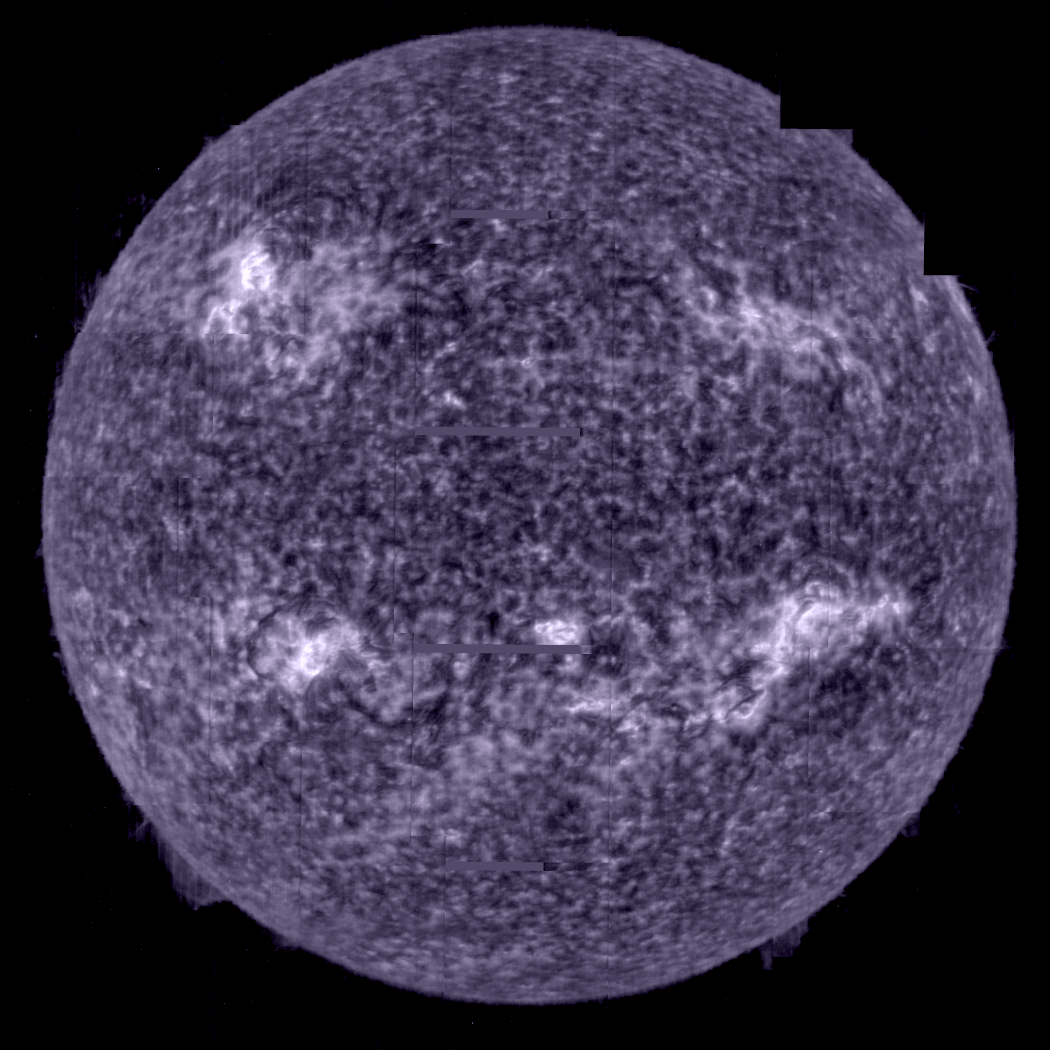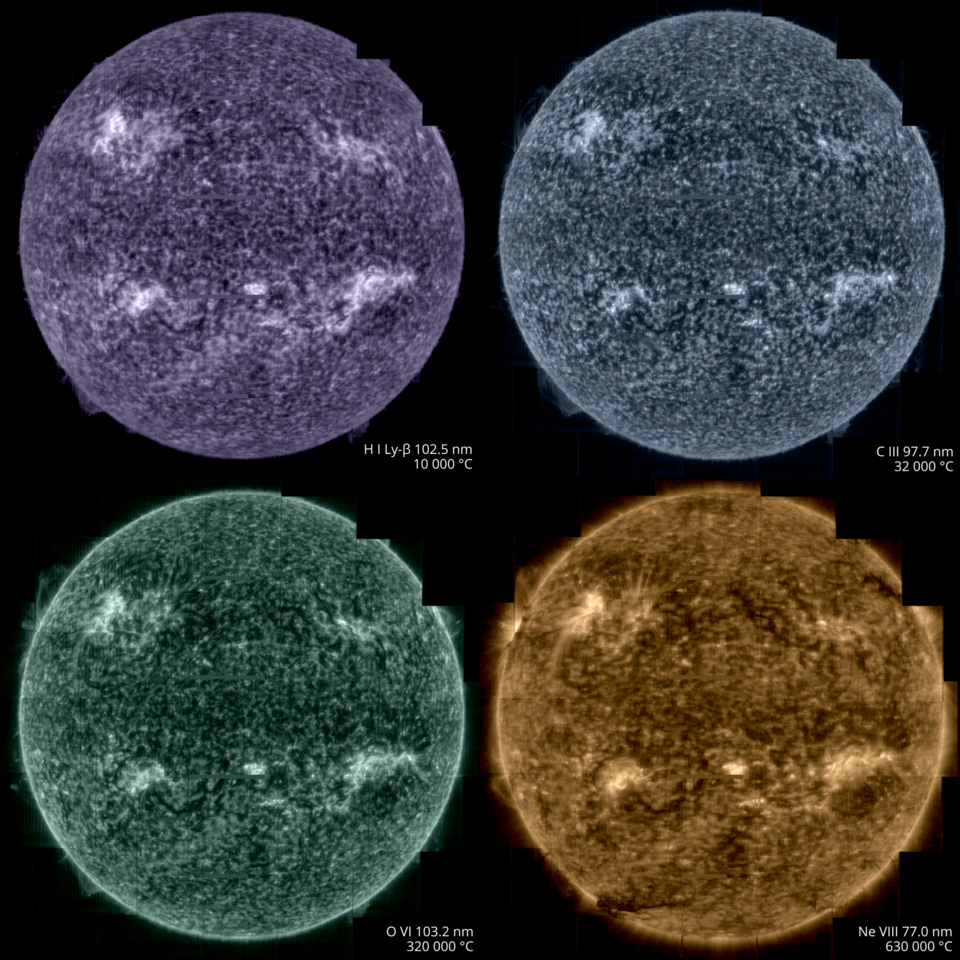26.03.2022
Zooming into the Sun with Solar Orbiter

Solar Orbiter’s latest images shows the full Sun in unprecedented detail. They were taken on 7 March, when the spacecraft was crossing directly between the Earth and Sun.
One of the images, taken by the Extreme Ultraviolet Imager (EUI) is the highest resolution image of the Sun’s full disc and outer atmosphere, the corona, ever taken.
Another image, taken by the Spectral Imaging of the Coronal Environment (SPICE) instrument represents the first full Sun image of its kind in 50 years, and by far the best one, taken at the Lyman-beta wavelength of ultraviolet light that is emitted by hydrogen gas.
Scroll and zoom into this high resolution image of the Sun from Solar Orbiter.
Credit: ESA & NASA/Solar Orbiter/EUI team; Data processing: E. Kraaikamp (ROB)
The images were taken when Solar Orbiter was at a distance of roughly 75 million kilometres, half way between our world and its parent star. The high-resolution telescope of EUI takes pictures of such high spatial resolution that, at that close distance, a mosaic of 25 individual images is needed to cover the entire Sun. Taken one after the other, the full image was captured over a period of more than four hours because each tile takes about 10 minutes, including the time for the spacecraft to point from one segment to the next.
In total, the final image contains more than 83 million pixels in a 9148 x 9112 pixel grid. For comparison, this image has a resolution that is ten times better than what a 4K TV screen can display.
EUI images the Sun at a wavelength of 17 nanometers, in the extreme ultraviolet region of the electromagnetic spectrum. This reveals the Sun’s upper atmosphere, the corona, which has a temperature of around a million degrees Celsius.
At the 2 o’clock (near the image of the Earth for scale) and 8 o’clock positions on the edges of the Sun, dark filaments can be seen projecting away from the surface. These ‘prominences’ are prone to erupt, throwing huge quantities of coronal gas into space and creating ‘space weather’ storms.

In addition to EUI, the SPICE instrument was also recording data during the crossing. These too needed to be pieced together as a mosaic.
SPICE is designed to trace the layers in the Sun’s atmosphere from the corona, down to a layer known as the chromosphere, getting closer to the surface. The instrument does this by looking at the different wavelengths of extreme ultraviolet light that come from different atoms.
In the SPICE sequence of images purple corresponds to hydrogen gas at a temperature of 10 000°C, blue to carbon at 32 000°C, green to oxygen at 320 000°C, yellow to neon at 630 000°C.
This will allow solar physicists to trace the extraordinarily powerful eruptions that take place in the corona down through the lower atmospheric layers. It will also allow them to study one of the most puzzling observations about the Sun: how the temperature is rising through the ascending atmospheric layers.

Usually the temperature drops as you move away from a hot object. But above the Sun, the corona reaches a million degrees Celsius whereas the surface is only about 5000°C. Investigating this mystery is one of the key scientific objectives of Solar Orbiter.
The images were taken on 7 March, precisely when Solar Orbiter crossed the Sun-Earth line, so the images can be compared with Earth-bound solar instruments and cross-calibrated. This will make it easier to compare results from different instruments and observatories in future.
On 26 March, Solar Orbiter reaches another mission milestone: its first close perihelion. The spacecraft is now inside the orbit of Mercury, the inner planet, taking the highest resolution images of the Sun it can take. It is also recording data on the solar wind of particles that flows outwards from the Sun.
And this is just the start, over the coming years the spacecraft will repeatedly fly this close to the Sun. It will also gradually raise its orientation to view the Sun’s previously unobserved polar regions.
Solar Orbiter is a space mission of international collaboration between ESA and NASA.
Quelle: ESA
----
Update: 29-03.2022
.
Solar Orbiter successfully completes historic close pass of the Sun

On March 26, 2022, the joint European Space Agency (ESA) and NASA Solar Orbiter spacecraft successfully completed its first close pass through the Sun’s corona, bringing the spacecraft’s specially-designed collection of instruments closer to the Sun than ever before.
During the close pass, called perihelion, all ten of Solar Orbiter’s instruments operated simultaneously, working together to gather important, never-before-seen data. The flyby brought Solar Orbiter less than one-third of the distance from the Sun to the Earth.
Solar Orbiter’s historic perihelion
Solar Orbiter launched on February 9, 2020, atop a United Launch Alliance (ULA) Atlas V rocket. Since being released by the rocket’s Centaur upper stage, Solar Orbiter has been traveling through interplanetary space in a heliocentric orbit.
In order to lower its perihelion — the point in its orbit closest to the Sun — Solar Orbiter needs to perform several gravity assists with Earth and Venus to achieve a targeted perihelion of 0.28 AU. Additionally, these gravity assist maneuvers help raise the inclination of Solar Orbiter’s orbit, allowing the spacecraft to provide the first views of the Sun’s uncharted polar regions. During its primary mission, Solar Orbiter’s orbital inclination will increase from 0° to 24°.
On June 15, 2020, Solar Orbiter made its first close pass of the Sun. At the time of this first close pass, Solar Orbiter’s perihelion was only 77 million kilometers, around the halfway point between the Sun and Earth. During this first perihelion, Solar Orbiter teams tested each of the spacecraft’s ten instruments, imaging the Sun and collecting a plethora of data on the Sun’s unique processes
The ten instruments aboard Solar Orbiter are the Energetic Particle Detector (EPD), Magnetometer (MAG), Radio and Plasma Waves (RPW), Solar Wind Plasma Analyser (SWA), Extreme Ultraviolet Imager (EUI), Coronagraph (Metis), Polarimetric and Helioseismic Imager (PHI), Heliospheric Imager (SoloHI), Spectral Imaging of the Coronal Environment (SPICE), and X-ray Spectrometer/Telescope (STIX).
As Solar Orbiter made its close approach to the Sun, all ten of its instruments were operating and collecting valuable data on the Sun’s characteristics. Now that the flyby is complete, Solar Orbiter scientists from ESA and NASA will spend weeks scouring over and analyzing these data and images.
During the March 26 flyby, Solar Orbiter made its closest approach yet at 48 million kilometers from the Sun’s surface – less than one-third of the distance between the Sun and the Earth. Solar Orbiter crossed the orbit of Mercury on March 14 and will pass back through it on April 6 as it moves farther from the Sun again. The images of the Sun taken by Solar Orbiter will be the closest images of the solar surface ever taken, and are expected to be released in a few weeks.
Solar Orbiter takes images at the Earth-Sun line
As Solar Orbiter was making its trek toward perihelion, it passed a crucial point in space: the Earth-Sun line. The Earth-Sun line is the point in interplanetary space that marks the halfway point between the Sun and the Earth. As Solar Orbiter crossed this line its instruments were used to take extremely high-definition images of the Sun’s surface.
Taking images at the Earth-Sun line will allow scientists to compare data and images from Solar Orbiter with other space-based and ground-based solar telescopes. One of the mosaic images Solar Orbiter captured is the highest-resolution image of the Sun’s corona and full disk ever taken.

The highest resolution image of the Sun’s corona and disk ever taken. (Credit: ESA/NASA/Solar Orbiter/EUI team; Data processing: E. Kraaikamp (ROB))
The image was taken in the extreme ultraviolet by Solar Orbiter’s Extreme Ultraviolet Imager (EUI) instrument. The EUI takes images in the extreme ultraviolet at a wavelength of 17 nanometers. Imaging the Sun at this wavelength reveals the corona, the Sun’s upper atmosphere.
In the image, two dark “prominences,” which are large, bright features extending outward from the Sun’s surface, can be seen at the two o’clock and eight o’clock positions on the Sun (relative to the direction of the image). These prominences are often prone to erupting, ejecting massive amounts of solar material out into the solar system in events called coronal mass ejections (CME). These CMEs are what typically cause “solar storms” on Earth.
Recently, one of these CMEs caused a geomagnetic storm to occur in Earth’s magnetosphere, which led to the loss of approximately 40 SpaceX Starlink satellites.
The EUI was not the only instrument taking data and acquiring images of the Sun at the Earth-Sun line. The Spectral Imaging of the Coronal Environment (SPICE) instrument captured a variety of mosaic images in varying wavelengths of extreme ultraviolet light, including an image of the Sun at the Lyman-beta wavelength of ultraviolet light — the first of its kind in nearly 50 years. SPICE is designed to measure the many layers of the Sun’s atmosphere, all the way from the upper corona to the lower chromosphere.
SPICE imaged the Sun in wavelengths corresponding to four different temperatures, each corresponding to emissions caused by a certain element in the Sun’s atmosphere: 10,000°C (hydrogen), 32,000°C (carbon), 320,000°C (oxygen), and 630,000°C (neon). For comparison, each element is shown in a different color: hydrogen is shown in purple, carbon in blue, oxygen in green, and neon in yellow.

These images, taken by Solar Orbiter’s SPICE instrument, show certain elements in the Sun’s atmosphere at different temperatures. (Credit: ESA/NASA/Solar Orbiter/SPICE team; Data processing: G. Pelouze (IAS))
Using SPICE’s images and other instruments and systems aboard Solar Orbiter, solar physicists will be able to pinpoint the exact layers at which solar prominences erupt and trace them to their origin. Additionally, SPICE will allow solar physicists to gain a better understanding of how heat rises through the Sun’s atmosphere — one of the most puzzling mysteries in heliophysics.
Generally, as you move away from a heated object, the amount of heat it emits decreases the farther you get from the source of the heat. In the Sun’s case, its core is the source of its heat, so it’s easy to assume that the Sun’s outermost atmospheric layer, the corona, would be cooler than the surface.
However, this is not the case.
In reality, the corona is around one million degrees Celsius, while the surface of the Sun is only 5,000°C — a startling and extremely puzzling mystery that solar physicists have been trying to solve for years. Determining the exact cause of this phenomenon is one of the key objectives of Solar Orbiter’s seven-year primary mission.

